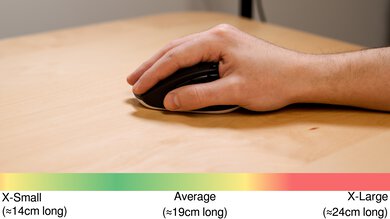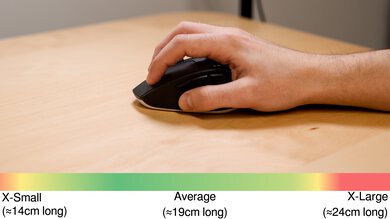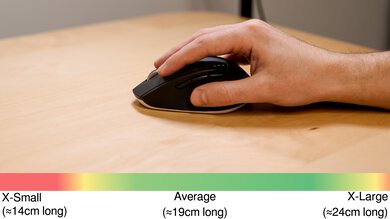The Logitech M720 Triathlon is an ergonomic wireless mouse designed for productivity and everyday use. It features an ergonomic shape with a thumb rest, a scroll wheel that unlocks for free scrolling, and L/R tilts for navigating spreadsheets or documents horizontally. It has multi-device support, where you can pair it with three devices at once through Bluetooth and its USB receiver and switch between them with its third side button. It's almost identical to the Logitech Precision Pro, a Costco variant, with some minor color differences.
Our Verdict
The Logitech M720 is a great mouse for office use. It feels impressively well-built, and it has an ergonomic shape and a thumb rest that will make it feel very comfortable for most hand sizes during long periods of use. It has a fair number of programmable buttons and nice features like gesture commands, both infinite and notched scrolling, and multi-device pairing.
- Feels very comfortable and well-built.
- Multi-device pairing.
- Fully compatible with Windows and macOS.
- Gesture commands and infinite scroll.
- Might feel too small for larger hands.
The Logitech M720 is decent for FPS gaming. Although it's very comfortable to use and feels well-built, it's quite heavy, and its click latency is too high for competitive gaming. Also, its CPI can't be adjusted, and its maximum polling rate is very low.
- Feels very comfortable and well-built.
- Decent sensor latency.
- Quite heavy.
- CPI range can't be adjusted.
- Low polling rate.
The Logitech M720 is decent for MMO gaming. It has great build quality and a fair amount of additional programmable buttons. However, its low polling rate and high click latency make it unsuitable for competitive gaming. Also, it doesn't have nearly as many side buttons as dedicated MMO mice have, but at least you can reprogram some of its inputs to your needs.
- Feels very comfortable and well-built.
- Great customization software.
- Might feel too small for larger hands.
- CPI range can't be adjusted.
- Low polling rate.
The Logitech M720 has mediocre raw performance. It has okay click latency and sensor latency, which are suitable for everyday tasks. It has a polling rate of 125Hz, which hinders its overall performance, but it provides the mouse with a very long battery life.
- Decent sensor latency.
- CPI range can't be adjusted.
- Low polling rate.
Changelog
-
Updated Oct 29, 2025:
We've added a link to the Logitech MX Master 4 in the Additional Buttons section.
- Updated Aug 19, 2025: We've converted this review to Test Bench 1.5.1. This update removes less relevant or redundant elements, including several videos. We've also adjusted our Sensor Latency testing, resulting in minor score changes. See our full 1.5.1 changelog for details.
- Updated Aug 29, 2024: We've added a link to the recently reviewed Logitech M340 in the Portability section of the review.
- Updated Apr 18, 2024: We've added a link to the 3Dconnexion CadMouse Pro Wireless in the Additional Buttons section of this review.
Check Price
Differences Between Sizes And Variants
The Logitech M720 Triathlon has a Costco variant called the Logitech Precision Pro. The biggest difference is their colors: The M720 Triathlon is black with a white underside, while the Precision Pro is black all over. Aside from some slight differences in performance that may be due to testing variations, the two mice are almost identical. You can view the label of our unit here.
Popular Mouse Comparisons
The Logitech M720 Triathlon is an excellent mouse for office use thanks to its comfortable, ergonomic shape and multi-device pairing capability. While its small size makes it unsuitable for people with larger-sized hands, it'll be more ideal for smaller-sized hands than the bulkier Logitech MX Master 2S and Logitech MX Master 3. The Triathlon has similar features to the MX line but is much more budget-friendly.
For other options, check out our recommendations for the best ergonomic mouse, the best wireless mouse, and the best Logitech mouse.
The Logitech M720 Triathlon and the Logitech Marathon Mouse M705 are office mice with similar looks, but the Triathlon is a better mouse with more features. The Triathlon has a sturdier-feeling build, Bluetooth support, and a button on the thumb rest for gesture commands. It also has better mouse feet made of PTFE rather than plastic and is ideal for a fingertip grip, regardless of hand size. On the other hand, the Marathon is suitable for all hand sizes, depending on grip type. It also has a slightly lower click latency but doesn't support Bluetooth, so it only connects wirelessly with its USB receiver.
The Logitech MX Master 3S and the Logitech M720 Triathlon are both productivity mice with ergonomic, right-handed shapes. The MX Master 3S has several features the Triathlon lacks, including a secondary scroll wheel for horizontal scrolling and quieter click buttons. It also uses Logitech's new BOLT USB receiver, while the Triathlon uses the older Unifying USB Receiver. On the other hand, the M720 Triathlon is slightly smaller and more portable. It also uses an AA battery for power, while the MX Master 3S recharges with an included USB cable.
The Logitech M720 Triathlon and the Logitech Signature M650 are both wireless mice designed for office use; however, the M720 Triathlon performs better overall. It has a button behind the scroll wheel, which allows you to toggle between notched and free-scrolling modes. Also, it can connect with up to three devices wirelessly using Bluetooth. On the other hand, the Signature M650 comes in two size variants and a left-handed variant, which is difficult to find for an office mouse.
The Logitech M720 Triathlon and the Logitech MX Anywhere 3S are productivity-focused wireless mice. The M720 Triathlon is larger, somewhat sturdier feeling, and has a more ergonomic right-handed shape. It also has an integrated gesture button on the thumb rest, and its scroll wheel has left and right tilt inputs. It connects wirelessly via Bluetooth or Logitech's Unified Receiver. On the other hand, the MX Anywhere 3S is somewhat smaller and lighter. It has a symmetrical shape and is designed more with portability in mind. Its sensor has a higher maximum CPI, and it has quieter mouse clicks.
Test Results

The Logitech M720 Triathlon has a simple, professional design similar to the Logitech MX Master 2S and Logitech MX Master 3. It looks almost identical to the Logitech Precision Pro, except its underside is white instead of black. Its L/R clicks are made of black plastic with a matte finish, and its sides are covered with rubber grips. Since it has a thumb rest on its left side, it's designed for right-handed people.
While this mouse is quite heavy compared to gaming models, you're unlikely to experience any discomfort using this mouse for long periods for work or everyday browsing. This mouse doesn't include any weight optimization features. However, you can use an AAA battery adapter, which allows you to power the mouse with an AAA battery rather than an AA battery, which is how the Lowest Weight result is obtained.
Thanks to its high back and the thumb rest on its left side, the Logitech M720 Triathlon will feel very comfortable for right-handed people. However, due to its compact size, people with larger hands may be unable to grip it comfortably with a palm or claw grip. Also, its tall hump might be an issue for users with small hands for certain grip styles. Otherwise, all of its buttons feel well-placed and reachable.
The Logitech M720 Triathlon has fantastic wireless versatility. You can pair it to three devices through Bluetooth and its USB receiver, and you can easily switch between them using its dedicated side button. It uses one AA battery that Logitech claims will last 24 months. If you're considering a more basic, wired office mouse, check out the Logitech M100.
This mouse is wireless only and doesn't have a cable.
The left- and right-click buttons on this mouse use non-specified mechanical switches. They have a fairly satisfying tactile feel but are also somewhat loud compared to many switches used in more recent Logitech releases. For more details, see the Noise section.
The Logitech M720 has a decent number of buttons. You can reprogram the L/R tilts, the scroll wheel click, the two first side buttons, and the button on the thumb rest through the Logitech Options software. Its third side button lets you easily switch between three paired devices, and the button below the scroll wheel lets you unlock infinite scrolling. It has a button on its thumb rest that enables gesture commands for as long as you press it.
If you're interested in a similar wireless productivity mouse that has a dedicated middle mouse button, see our review for the 3Dconnexion CadMouse Pro Wireless.
Or, for a more premium productivity option with dual scroll wheels, a dedicated side button for gestures, and a haptic button you can customize with context-specific shortcuts, check out the Logitech MX Master 4.
The Logitech M720 has okay click latency. It's too high for competitive or reaction-based games but well-suited for daily browsing tasks and casual gaming.
If you're interested in a similar wireless mouse but with better raw gaming performance and many of the same productivity features, check out our review for the Keychron M6.
The Logitech M720 has good CPI performance. While its tracking error and accuracy variation make it unsuitable for competitive gaming, its performance in everyday tasks will be adequate for most users.
Note: Since the CPI of this mouse is fixed at 1000 CPI, we used Logitech's Options app to set pointer speed at the different CPI levels for our SRAV tests.
This mouse has decent sensor latency that's fine for productivity and everyday browsing. The sensor reacts quickly enough when you mouse your mouse, so you don't perceive any noticeable delays with the timing of the movements to your cursor on-screen. However, its 125Hz polling rate makes it unsuitable for competitive gaming.
The Logitech M720 uses an optical LED sensor that's fixed at 1000 CPI. Unlike most of Logitech's MX line, you can't adjust the native CPI on this mouse. However, there's a pointer speed option in the Logitech Options software that you can customize to increase the cursor speed. Except for a slight difference in the CPI variation, the sensor specifications are identical to the results we got for the Logitech Precision Pro, although this deviation may be due to testing variations.
The mouse wheel is grippy thanks to the texturized rubber strip wrapped around it. It has L/R tilts, and you can unlock infinite scrolling by hitting the button below the scroll. The mouse wheel has less resistance than the Logitech Precision Pro. However, since these two mice appear to be practically identical, this may be due to manufacturing differences and may vary between units. If you're interested in a more premium office mouse with a wheel that automatically shifts to free scrolling when you scroll quickly and a second dedicated scroll wheel for horizontal scrolling, check out the Logitech MX Master 3S.
The Logitech M720 wireless mouse is loud but won't bother people around you unless you're in a quiet environment. If you're looking for an office mouse with very quiet switches, check out the Logitech Signature M650.
The Logitech Options app is very user-friendly and easy to use. You can reprogram most of its buttons by choosing from a list of functions. While you can't change the native CPI, there's a pointer speed option that you can adjust in the software. Unfortunately, the mouse doesn't have on-board memory, so you can't save and maintain your settings when moving to another computer. On the bright side, it's available on both Windows and macOS.












